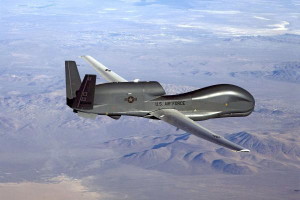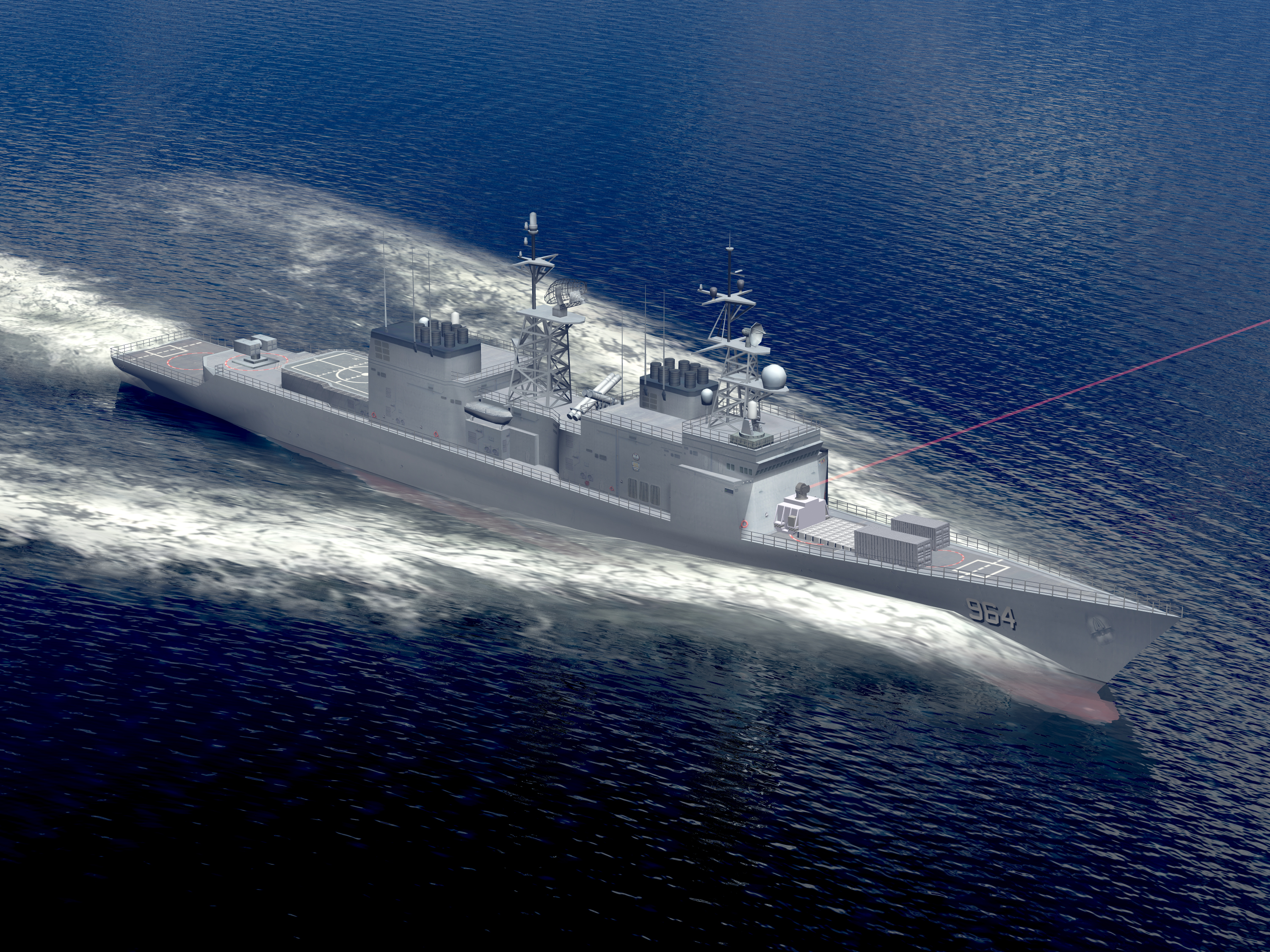Daily Business Report-Dec. 23, 2015
Illustration: Northrop Grumman will assist the Navy in testing a Laser Weapon System Demonstrator aboard the service’s Self Defense Test Ship, the former USS Paul F. Foster.
Navy Selects Northrop Grumman to Design
And Build Shipboard Laser Weapons System
The U.S. Navy will get a peek at a future where high-energy laser weapons could defend its ships against attack under a $53 million contract awarded to Northrop Grumman Corp. by the Office of Naval Research.
Under the three-phase Laser Weapon System Demonstrator contract, the company will design, produce, integrate, and support the shipboard testing of a 150-kilowatt-class solid state (electric) laser weapon system.
The initial award of $53 million will support work planned for the next 12 months. The contract could grow to a total value of $91 million over 34 months if ONR exercises all of its contract options.
“Northrop Grumman is integrating the latest in high-energy lasers with more than 40 years of experience as a laser weapon system integrator to protect sailors against last-minute, high impact threats,” said Guy Renard, director and program manager for Northrop Grumman Aerospace Systems. “For about the price of a gallon of diesel fuel per shot, we’re offering the Navy a high-precision defensive approach that will protect not only its sailors, but also its wallet.”
During Phase 1 of the contract, Northrop Grumman will develop a detailed design for the new system. Phase 2 will include assembly and ground test of the system, while Phase 3 will comprise at-sea testing of the system aboard the Navy’s Self Defense Test Ship. The Navy will lead this testing with Northrop Grumman providing technical support. The SDTS is the former USS Paul F. Foster.
According to Renard, Northrop Grumman’s laser weapons system is well suited to support the Navy’s planned initial testing. The company has designed its system to be installed, however, with minimal modification or additional costs, for demonstration on Navy destroyers.
Future Navy laser weapon systems could eventually protect a wide array of naval platforms from advanced surface and air threats.
__________________________________________________

Scripps Launches New Retail Clinic
In University City With the Irvine Company
Scripps Health and the Irvine Company announced the opening of Scripps HeathExpress, a new retail health clinic designed to offer convenient health and wellness services at an Irvine Company office complex in University City.
The 1,691-square-foot facility at The Plaza (4350 La Jolla Village Drive, Suite 130) features a medical office with four exam rooms and offers a wide variety of medical and wellness services on an appointment and walk-in basis.
“At Scripps, we believe it is important that health care is convenient and affordable,” said Chris Van Gorder, Scripps president and CEO. “Scripps HealthExpress provides health care close to where people work, which makes getting the care they need that much easier and we also want to work with employers across the region to help them maintain a healthy workplace.”
This is the first health care facility in San Diego County to open in a workplace community. It marks Scripps’ expansion into retail health and Irvine Company’s growing focus on wellness amenities and services for its customers.
“Our research tells us healthy and happy employees are most productive,” said Doug Holte, president, Irvine Company Office Properties.
General Atomics Delivers Final
2 Predators to Italian Air Force
General Atomics Aeronautical Systems Inc. announced that the Italian Air Force has accepted delivery of two RQ-1 Predator remotely piloted aircraft — marking final deliveries of the company’s Predator A product line.
“With the delivery of these aircraft, GA-ASI completes over two decades of delivering Predator A capabilities to the United States and allied countries,” said Frank W. Pace, president of aircraft systems. “Amassing over 2.1 million cumulative flight hours and featuring the highest mission capable rate of any aircraft in the Air Force’s inventory, Predators will continue to keep warfighters safe by equipping them with unparalleled situational awareness for many years to come.”
The Italian Air Force is a leader in the utilization of Predator and MQ-9 RPA to support a wide range of Intelligence, Surveillance, and Reconnaissance missions in Italy, over the Mediterranean, and in support of NATO operations. Italy is the first country in Europe to have achieved an RPA airworthiness certification.

Harry’s Bar and American Grill
Moving Afer 18 years in La Jolla
City News Service
Harry’s Bar and American Grill, an upscale restaurant and watering hole frequented by San Diego’s business elite, announced Tuesday it will close its current location across from Westfield UTC on Christmas Eve.
The eatery could reopen by February in Bankers Hill, according to the owner, Garo Minassian. He informed customers of the closure via email, and said he will announce the new address when negotiations are completed.
The restaurant — based on the fabled establishment in Italy favored by celebrities like Ernest Hemingway, Charlie Chaplin, Aristotle Onassis and Woody Allen — has been across from Westfield UTC in La Jolla for 18 years, according to Minassian.
“It’s a bittersweetness,” Minassian said about moving. “We’ve been here a long time. We’ll miss our customers.”
He said the restaurant’s landlord wanted to double the cost of his lease, prompting the move.
Air Force to Allow Enlisted Airmen
To Fly Northrop’s Global Hawk Drones
Military.com

Less than a week after Air Combat Command recommended the Air Force develop a career path for enlisted drone pilots, Air Force Secretary Deborah Lee James said they’ll be allowed to do so.
“The RPA enterprise is doing incredibly important work and this is the right decision to ensure the Air Force is positioned to support the future threat environment,” she said in an announcement, referring to the acronym for remotely piloted aircraft.
Enlisted airmen will be integrated into the service’s flying mission starting with the unarmed RQ-4 Global Hawk surveillance drone — the high-altitude reconnaissance drone made by Northrop Grumman Corp. — and suggested that over time they may also be flying weaponized MQ-1 Predators and MQ-9 Reapers made by General Atomics.
“What we learn from flying Global Hawks with enlisted pilots under the supervision of rated officers will inform whether we apply a similar approach to other weapon systems,” Air Force Chief of Staff Gen. Mark Welsh said. “It is too soon to speculate on any expansion of enlisted aircrew beyond the Global Hawk program.”
Air Combat Command will now develop a plan for bringing enlisted personnel into the RPA flying world — establishing entry requirements, training plans, career path development, duties, compensation and an appropriate force mix, the Air Force said.
The announcement of an enlisted RPA career path comes a day after the Air Force announced it would offer Critical Skills Retention Bonuses of as much as $125,000 to officers who now fly the aircraft.
Both decisions are driven by the shortage of drone pilots. The Los Angeles Times reported in November that records show the services has been struggling with manning since 2007, as experienced officer pilots leave the service rather than try to make a career in RPAs.
Pilots who have bailed on the Air Force say the stress and fatigue that go with the job became too much. The service trains about 180 such pilots a year.
RESEARCH
Loss of Tiny Genetic Molecules Could Play
Role in Diseases Such as Lou Gehrig’s Disease
A tiny sliver of a person’s DNA—several thousand times smaller than a typical gene—produces a molecule that has crucial influence over whether a person has any control over their muscles, according to a paper published December 18, 2015 in the journal Science.
In the paper, scientists at the Salk Institute report that animals unable to produce just one of many genetic molecules called microRNAs develop symptoms of devastating neurodegenerative diseases like amyotrophic lateral sclerosis (ALS or Lou Gehrig’s disease) and spinal muscular atrophy (SMA).
The findings upend previous understanding of the role of microRNAs in the nervous system and may open a door to new avenues for treating neurodegenerative disorders by correcting dysfunctional microRNAs.
“This really does open a new world of possibilities to another approach to understanding neurodegenerative diseases like these,” says senior author of the work Salk Professor Samuel Pfaff, who is also a Howard Hughes Medical Institute investigator and Benjamin H. Lewis Chair.
Researchers Study Physics
Of Protein Involved in Cancer

A new study led by scientists at The Scripps Research Institute and St. Jude Children’s Research Hospital shows how a protein involved in cancer twists and morphs into different structures.
“We’re studying basic biophysics, but we believe the complexity and rules we uncover for the physics of protein disorder and folding could one day also be used for better designs of therapeutics,” said TSRI Associate Professor Ashok Deniz, senior author of the new study along with Richard Kriwacki, faculty member at St. Jude.
The study, published recently in the journal Angewandte Chemie, focuses on a protein called nucleophosmin (NPM1). This protein has many functions and, when mutated, has been shown to interfere with cells’ normal tumor suppressing ability. NPM1 has been implicated in cancers such as non-Hodgkin lymphoma and acute myelogenous leukemia.
Previous research led by study collaborators Kriwacki and Diana Mitrea at St. Jude had shown that a section of NPM1, called the N-terminal domain (Npm-N), doesn’t have a defined, folded structure. Instead, the protein morphs between two forms: a one-subunit disordered monomer and a five-subunit folded pentamer.
Until now, the mechanism behind this transformation was unknown, but scientists believed this monomer-pentamer equilibrium could be important for the protein’s location and functioning in the cell.


